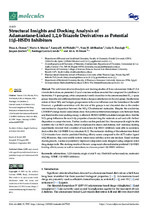| dc.contributor.author | Osman, Doaa, A | |
| dc.contributor.author | Macias, Mario, A | |
| dc.contributor.author | Zondagh, Luke, S | |
| dc.contributor.author | Joubert, Jacques | |
| dc.contributor.author | Al- Wahaibi, Lamya, H | |
| dc.contributor.author | Al- Shaalan, Nora, H | |
| dc.contributor.author | Garcia- Granda, Santiago | |
| dc.contributor.author | El-Emam, Ali, A | |
| dc.date.accessioned | 2021-09-27T08:00:21Z | |
| dc.date.available | 2021-09-27T08:00:21Z | |
| dc.date.issued | 2021 | |
| dc.identifier.citation | Osman, D.A. et al. (2021). Structural Insights and Docking Analysis of Adamantane-Linked 1,2,4-Triazole Derivatives as Potential 11_-HSD1 Inhibitors. Molecules, 26, 5335. https://doi.org/10.3390/ | en_US |
| dc.identifier.uri | https://doi.org/10.3390/ | |
| dc.identifier.uri | http://hdl.handle.net/10566/6818 | |
| dc.description.abstract | The solid-state structural analysis and docking studies of three adamantane-linked 1,2,4- triazole derivatives are presented. Crystal structure analyses revealed that compound 2 crystallizes in the triclinic P-1 space group, while compounds 1 and 3 crystallize in the same monoclinic P21/c space group. Since the only difference between them is the para substitution on the aryl group, the electronic nature of these NO2 and halogen groups seems to have no influence over the formation of the solid. However, a probable correlation with the size of the groups is not discarded due to the similar intermolecular disposition between the NO2/Cl substituted molecules. Despite the similarities, CE-B3LYP energy model calculations show that pairwise interaction energies vary between them, and therefore the total packing energy is affected. HOMO-LUMO calculated energies show that the NO2 group influences the reactivity properties characterizing the molecule as soft and with the best disposition to accept electrons. Further, in silico studies predicted that the compounds might be able to inhibit the 11 -HSD1 enzyme, which is implicated in obesity and diabetes. Self- and cross-docking experiments revealed that a number of non-native 11 -HSD1 inhibitors were able to accurately dock within the 11 -HSD1 X-ray structure 4C7J. The molecular docking of the adamantane-linked 1,2,4-triazoles have similar predicted binding affinity scores compared to the 4C7J native ligand 4YQ. However, they were unable to form interactions with key active site residues. Based on these docking results, a series of potentially improved compounds were designed using computer aided drug design tools. The docking results of the new compounds showed similar predicted 11 -HSD1 binding affinity scores as well as interactions to a known potent 11 -HSD1 inhibitor. | en_US |
| dc.language.iso | en | en_US |
| dc.publisher | Molecules | en_US |
| dc.subject | Adamantane | en_US |
| dc.subject | 1,2,4-triazole | en_US |
| dc.subject | Single crystal X-ray | en_US |
| dc.subject | Hirshfeld surface analysis | en_US |
| dc.subject | Molecular docking | en_US |
| dc.subject | ADME | en_US |
| dc.subject | 11 -HSD1 inhibitors | en_US |
| dc.title | Structural Insights and Docking Analysis of Adamantane-Linked 1,2,4-Triazole Derivatives as Potential 11 -HSD1 Inhibitors | en_US |
| dc.type | Article | en_US |

